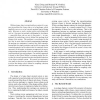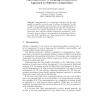212 search results - page 9 / 43 » A Unified Model of Structural Organization in Language and M... |
AGENTS
2001
Springer
14 years 12 hour ago
2001
Springer
The specific organization used by a multi-agent system is crucial for its effectiveness and efficiency. In dynamic environments, or when the objectives of the system shift, the ...
CMOT
1998
13 years 7 months ago
1998
A programming language which is optimized for modelling multi-agent interaction within articulated social structures such as organizations is described with several examples of it...
ICSM
2009
IEEE
14 years 2 months ago
2009
IEEE
Within a large, object-oriented software system it is common to partition the classes into a set of packages, which implicitly serve as a set of coarsely-grained logical design un...
SOCO
2008
Springer
13 years 7 months ago
2008
Springer
Superimposition is a composition technique that has been applied successfully in several areas of software development. In order to unify several languages and tools that rely on s...
DAGSTUHL
2007
13 years 9 months ago
2007
Local tag structures have become frequent through Web 2.0: Users "tag" their data without specifying the underlying semantics. Every user annotates items in an individual...


